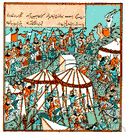Tam·er·lane
(tăm′ər-lān′) or Tam·bur·laine (-bər-) Originally Timur. 1336-1405. Mongolian conqueror who led his nomadic hordes from their capital at Samarqand in central Asia to overrun vast areas of Persia, Turkey, Russia, and India.
American Heritage® Dictionary of the English Language, Fifth Edition. Copyright © 2016 by Houghton Mifflin Harcourt Publishing Company. Published by Houghton Mifflin Harcourt Publishing Company. All rights reserved.
Tamburlaine
(ˈtæmbəˌleɪn)n
(Biography) another name for Tamerlane
Collins English Dictionary – Complete and Unabridged, 12th Edition 2014 © HarperCollins Publishers 1991, 1994, 1998, 2000, 2003, 2006, 2007, 2009, 2011, 2014
Tam•er•lane
(ˈtæm ərˌleɪn)also Tamburlaine
n.
(Timur Lenk) 1336?–1405, Tartar conqueror in S and W Asia.
Also called Timur. Random House Kernerman Webster's College Dictionary, © 2010 K Dictionaries Ltd. Copyright 2005, 1997, 1991 by Random House, Inc. All rights reserved.
ThesaurusAntonymsRelated WordsSynonymsLegend:
| Noun | 1. |  Tamburlaine - Mongolian ruler of Samarkand who led his nomadic hordes to conquer an area from Turkey to Mongolia (1336-1405) Tamburlaine - Mongolian ruler of Samarkand who led his nomadic hordes to conquer an area from Turkey to Mongolia (1336-1405) |
Based on WordNet 3.0, Farlex clipart collection. © 2003-2012 Princeton University, Farlex Inc.